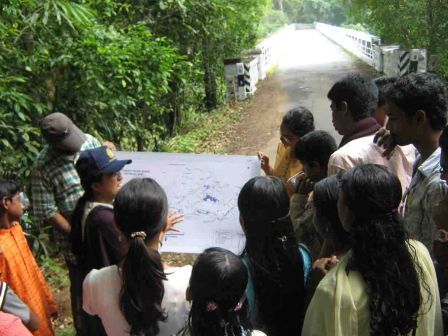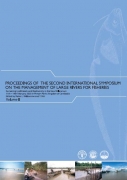Bay of Bengal
Review of Krishna Water Disputes Tribunal - A report on Krishna river water allocations
Posted on 08 Mar, 2011 04:42 PMThis is a review of KWDT-2 report analysing how it has failed to protect the long term sustainable productivity and ecology of the river basin. It has also failed to understand the water allocations done by previous KWDT-1. KWDT-2 also negated the earlier KWDT-1 allocations at the same time categorically stating that it cannot change water use allocations of previous award.
River schools can make the future look bright - Parineeta Dandekar
Posted on 04 Mar, 2011 01:25 PM Above - Children studying a map of the Chalakudy Basin. Photo - RRC.
Above - Children studying a map of the Chalakudy Basin. Photo - RRC.
Seeds of sustainability and sensitivity when sown at a young age, blossom into responsible individuals. And you need to be in touch with the land to sow those seeds. The Central and State Boards of Education in India have made Environmental Science a compulsory subject for schools and junior colleges (for all subjects). But Environmental Sciences is not to be studied in the classroom. In order to understand the erosion and deposition processes of a river, students need to visit a river bend in their city and in order to instil a lifelong aversion to plastic bags, a landfill and dumping grounds need to be seen.
Review needed on Krishna Water Tribunal analysis on Alamatti Dam to save the farmers from dangerous consequences
Posted on 15 Feb, 2011 11:57 AMProf.T.Shivaji Rao, Director, Center for Environmental Studies, Gitam University and former member of the Environmental Appraisal Committee of Union Government in 1990 when the Alamatti project was placed before the committee for clearance.
Two ancient irrigation systems of India - Paper presented at the National Seminar on Water and Culture (2007)
Posted on 14 Feb, 2011 05:03 AMThe Phad system of irrigation, is found in Maharashtra over the rivers Panzara, Girna and Burai, which are tributaries of Tapi.
Water management in the Vijaynagar empire - Paper presented at the National Seminar on Water and Culture (2007)
Posted on 14 Feb, 2011 01:55 AMThis paper focuses on water management techniques used in two tanks constructed by the kings of the Vijaynagar Empire.
The first example taken, is that of the Anantraj Sagar built by the son of the minister of Harihar. The lake is still in use and there are inscriptions on stone near it which provide a thumb rule to constructing lakes. Construction of this lake began in 1369 and was completed in 2 years. The paper states that the length of the dam was 5000 dand, width was 8 dand and the height was 7 dand (One dand is about one metre).
Irrigation in India - Management phases and its sustainability - Paper presented at the National Seminar on Water and Culture (2007)
Posted on 13 Feb, 2011 10:52 PMSince time immemorial water has been a common property and in many Indian communities there is deep reverence for flowing water. Using the flow of water for community benefit is considered an act of great merit and its misuse and contamination, a sin. In temples, tanks were constructed for rituals and also as a way to earn money for the temple.
Proceedings of the second international symposium on the management of large rivers for fisheries by FAO and Mekong River Commission
Posted on 03 Feb, 2011 07:55 PM The second international symposium on the management of large rivers for fisheries was held by the Food and Agriculture Organisation of the United Nations (FAO) and Mekong River Commission on 11 - 14 February 2003 in Phnom Penh, Kingdom of Cambodia. It had three primary objectives: (a) To provide a forum to review and synthesise the latest information on large rivers; (b) To raise the political, public and scientific awareness of the importance of river systems, the living aquatic resources they support and the people that depend on them; and (c) To contribute to better management, conservation and restoration of the living aquatic resources of large rivers.
The second international symposium on the management of large rivers for fisheries was held by the Food and Agriculture Organisation of the United Nations (FAO) and Mekong River Commission on 11 - 14 February 2003 in Phnom Penh, Kingdom of Cambodia. It had three primary objectives: (a) To provide a forum to review and synthesise the latest information on large rivers; (b) To raise the political, public and scientific awareness of the importance of river systems, the living aquatic resources they support and the people that depend on them; and (c) To contribute to better management, conservation and restoration of the living aquatic resources of large rivers.
The symposium was organised in six sessions:
Session 1: Status of rivers
Session 2: Value of river fisheries
Session 3: Fisheries ecology and conservation
Session 4: Management of river fisheries
Session 5: Statistics and information
Session 6: Synthesis
It came up with the following recommendations for action -
- Improve the valuation of living river resources in order to contribute to equitable and sustainable management of fishery resources and properly place the fishery in the context of the other uses of rivers.
- Direct greater effort to better understanding the social and economic aspects of fisheries to support policy and management priorities; livelihood approaches will be a valuable tool.
- Communicate and engage with environment and water resources managers within the context of multi-use of water in order to accurately assess impacts and to sustain the benefits of river fisheries in an equitable manner.
- Develop processes that facilitate the users and beneficiaries of the fishery resource to assume greater control of its management.
- Establish appropriate mechanisms at national and basin level to enable negotiation for the needs of communities dependent upon the living aquatic resources. In particular further regulations need to be elaborated to protect general ecosystem function and provide for environmental flows.
- Use instruments such as the freshwater eco-regions approach, the Ramsar Convention and the guidelines for water allocation suggested by the World Commission on Dams, to enhance planning for conservation and sustainable use of river habitats.
- Incorporate ecological flow requirements of river-floodplain systems into development plans and impact assessments that affect river flows, taking into account the seasonality of the system and the environmental cues needed by the fish for migration and reproduction.
- Rehabilitate degraded ecosystems wherever possible. Prioritize schemes that ensure connectivity and protection of critical habitats.
Groundwater flow modelling and aquifer vulnerability assessment in Yamuna–Krishni sub-basin of Muzaffarnagar district – A study by Central Ground Water Board and Aligarh Muslim University
Posted on 02 Feb, 2011 08:24 AMThis report by Aligarh Muslim University and Central Ground Water Board (CGWB) deals with groundwater flow modelling and aquifer vulnerability assessment in Yamuna–Krishni sub-basin of Muzaffarnagar district. For evaluation of the groundwater resources and for minimizing the error of estimation, the system has been evaluated through aquifer modelling where water balance is established using partial differential equation of groundwater flow and is solved with boundary and initial boundary conditions.
Eastern Himalaya freshwater biodiversity assessment report released by IUCN and Zoo Outreach Organisation
Posted on 18 Jan, 2011 11:44 PMDear all,
IUCN, with Zoo Outreach Organisation, have today published a new report, 'The status and distribution of freshwater biodiversity in the Eastern Himalaya', which is available online here